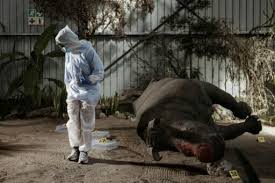News
Former prosecutors and conservationists build crime scene skills to help rangers protect wildlife in South Africa

Instead of dusty textbooks or computer screens, these students learn in a setting that looks like something from a crime drama — except the victims are wildlife, and the stakes are real.
Inside a warehouse on a game reserve north of Cape Town, students tiptoe through a simulated poaching scene featuring lifeless animal bodies and telltale clues.
But this isn’t a movie set — it’s part of South Africa’s Wildlife Forensic Academy.
Not Your Average Day in the Field
In the middle of the room lies a rhino, stiff in the sand with its horn violently removed.
Nearby, a dead giraffe and a lion’s twisted form complete the grim picture.
The bodies are taxidermied, but the lesson is real: how to investigate wildlife crime scenes and gather solid evidence.
The trainees, dressed in hazmat suits, are learning how to track footprints, secure a scene, and follow a trail — skills that could make or break a poaching investigation.
A New Front Line in the Fight Against Poaching
“This kind of training is critical,” said Phil Snijman, a former prosecutor who now teaches at the academy.
“The first people at the scene often determine whether the evidence holds up in court or gets lost forever.”
That’s a serious issue in South Africa, where rhino poaching has reached crisis levels.
Over 10,000 rhinos have been killed since 2007, yet in 2023, only 36 convictions were recorded — despite nearly 500 rhinos being killed that same year.
It’s Not Just Rhinos — And That’s the Problem
While rhinos and elephants dominate headlines, many smaller species are being wiped out with little fanfare — or justice.
Conservationist Wendy Willson, who works at Johannesburg’s Wildlife Veterinary Hospital, says many of these crimes never make it to court.
Even when they do, the outcomes are often disappointing.
“Sentences are usually too lenient, and many cases involving reptiles, vultures, and other less ‘popular’ species get ignored entirely,” she explained.
Connecting the Dots for Real-World Justice
For Willson and others, the gap in justice is about more than law enforcement availability.
It’s also about prosecutors understanding the seriousness of wildlife crimes, communities being part of the solution, and rangers having the tools and training to document everything properly.
Training rangers in forensics is a piece of the puzzle, but it won’t fix everything — there’s no silver bullet when it comes to poaching.
From Wild Dogs to Crime Scenes
For Mari-Su de Villiers, who works with endangered African wild dogs, joining the academy was personal.
Her team had once encountered an animal poisoning incident, and with the help of a trained colleague, they realized just how important proper evidence collection is.
Now, wearing gloves and placing yellow markers around Frikkie the poached rhino, she’s honing the skills that could help her bring real-world poachers to justice.
A Growing Global Classroom
Since opening in 2022, the Wildlife Forensic Academy has trained over 500 people.
Surprisingly, most aren’t rangers or conservation officers — many are students from Europe whose tuition helps fund scholarships for locals on the front lines.
Snijman hopes that by improving how evidence is collected and presented, the academy can lead to more convictions — and make poachers think twice before striking again.
A Grim But Necessary Mission
“No one wants to need a place like this,” Snijman admits, staring at the staged crime scene.
“But as long as wildlife crime exists, we’ll be here, doing our part.”
And with every footprint analyzed and every clue collected, these trainees inch closer to justice — not just for the iconic species that make the news, but also for the quiet ones disappearing without a trace.
News
rajkot updates news:when will the tesla phone be released in India ?

The idea of a Tesla smartphone has been circulating for years, and every new rumor adds more fuel to the excitement. People follow the updates closely, especially after reports like “Rajkot Updates News:when will the tesla phone be released” began trending. The public wants to know if Elon Musk is truly ready to challenge the smartphone industry with the same disruption Tesla brought to electric cars.
Many believe that if Tesla enters the smartphone market, it won’t be an ordinary device. The company is known for innovation, and fans expect groundbreaking features that could set new standards across the tech world. With so many leaks, predictions, and discussions online, it’s easy to see why this topic is gaining attention.
Why the Tesla Phone Rumors Started
Speculation about a Tesla phone began when designers and tech analysts created concept models showing futuristic smartphone capabilities. These ideas sparked conversations worldwide. Observers pointed out that Tesla already has a strong ecosystem, from cars to solar technology to energy storage, which could support a smartphone launch.
Another reason the rumors spread is Elon Musk’s involvement in multiple high-tech ventures like SpaceX, Neuralink, and Starlink. People imagine a phone that connects seamlessly with Tesla cars, integrates with Starlink satellites, and uses advanced AI like never before. The combination of all this makes the idea feel possible.
What “Rajkot Updates News” Reported
The phrase “Rajkot Updates News:when will the tesla phone be released” became popular on the internet after several regional tech pages and blogs discussed the potential launch timeframe. While no official statement was released, these reports suggested that Tesla might be preparing to break into the smartphone market soon.
The reports highlighted global excitement and mentioned that development might already be underway. Some writers claimed the release could happen within the next few years, while others predicted a much sooner debut. Still, these are just speculations and not confirmations from Tesla.
Has Tesla Confirmed the Tesla Phone Release Date?
As of now, Tesla has not announced any official release date for a smartphone. Elon Musk has neither confirmed nor denied the existence of such a device. He has, however, hinted that if current smartphone ecosystems restrict free speech or innovation, he might consider launching an alternative.
Even though no release date has been shared, experts believe that if a Tesla phone is in development, the company might reveal something within the next one to two years. Tech watchers keep a close eye on Tesla events, earnings calls, and Elon Musk’s social media posts for clues.
What Features People Expect From the Tesla Phone
Fans expect the Tesla phone to look different from any other smartphone. One of the biggest predictions is Starlink satellite connectivity, which could allow users to access the internet in remote locations without relying on telecom networks. This would be a major breakthrough for global communication.
Another expectation is deep integration with Tesla cars. People imagine controlling vehicle functions such as autopilot, climate, and charging directly through the phone. There are also rumors about solar charging support, advanced AI features, and Neuralink compatibility, although these ideas are not confirmed.
Why a Tesla Phone Would Be a Game-Changer
If Tesla enters the smartphone market, the impact would be immediate. The company has a strong brand identity and loyal following. Its approach to design and technology often influences the entire industry. The thought of a Tesla phone disrupts the competition even before its launch.
A smartphone built around Tesla’s ecosystem can redefine how people interact with technology. With AI, satellites, and EV integration, Tesla has the potential to build a product that blends hardware, software, transportation, and communication in a unique way.
Challenges Tesla May Face Before Releasing a Phone
Despite the excitement, launching a smartphone is not easy. Major companies like Apple, Samsung, and Google dominate the market. Any new phone must offer strong hardware, long-term software support, and a huge app ecosystem. Tesla will need to address these challenges to compete.
Manufacturing a smartphone on a global scale also requires partnerships, supply chain stability, and regulatory approvals. With Tesla already managing large-scale car production, adding another complex product may require significant planning and investment.
Global Interest Around “Tesla Phone Release Date”
Search trends show rising interest in keywords like Tesla phone release date, Tesla Model Pi, and Tesla smartphone leaks. This is especially true in countries where Tesla has strong brand recognition. Reports from regions like Rajkot helped boost curiosity even more.
Tech enthusiasts, YouTubers, and bloggers continue analyzing every new rumor. The possibility of a Tesla phone has become a major conversation topic, even though the company has not confirmed anything. This shows the power of Tesla’s influence in the tech world.
Could the Tesla Phone Be Called “Model Pi”?
One common name circulating online is Tesla Model Pi. This name fits Tesla’s naming strategy, similar to Model S, Model 3, and Model X. Designers have posted concept images using this name, showing unique features like color-changing skins and advanced cameras.
However, it is important to remember that “Model Pi” is not an official name. It is only a fan created concept. If Tesla ever announces a phone, the actual product name could be completely different.
What We Know So Far
While nothing is confirmed, the growing number of discussions suggests that people truly believe Tesla might introduce a smartphone. The topic has global traction, and reports like “Rajkot Updates News:when will the tesla phone be released” only push the excitement further.
The tech world watches closely, waiting for any official update. With Tesla’s reputation for surprising announcements, people expect that if a smartphone is coming, the reveal will be groundbreaking.
Conclusion
The interest around the Tesla phone continues to rise, even without an official confirmation. Reports, leaks, and fan expectations have created a global conversation that won’t slow down anytime soon. While “Rajkot Updates News” helped highlight the buzz, the big question remains: When will the Tesla phone actually be released?
For now, the best approach is to stay alert for official announcements from Tesla. Whether it happens soon or later, one thing is clear: a Tesla phone has the potential to reshape the smartphone market in a major way.
FAQs
What is the Tesla Phone and why is it trending?
The Tesla Phone is a rumored smartphone project linked to Tesla, expected to include advanced features that reflect the company’s innovation in tech and AI. It is trending due to leaks, predictions, and high public interest.
Has Tesla confirmed an official release date?
No official release date has been announced. Most information comes from predictions, industry insiders, and regional news updates like Rajkot reports.
What features are expected in the Tesla Phone?
Common expectations include deep AI integration, satellite connectivity, fast charging, solar support, and smooth compatibility with Tesla cars and smart devices.
Why is Rajkot news covering the Tesla Phone release?
Rajkot often reports on global tech trends. The Tesla Phone is a major topic worldwide, and regional news platforms are sharing local insights and global predictions.
Will the Tesla Phone be available in India at launch?
There is no confirmed market list yet. Analysts believe India is likely to be included because of its fast-growing smartphone market.
News
KVK-Tech Warning Letter: What It Means for Pharma Compliance

What is a Warning Letter and Why Does It Matter?
A warning letter from the U.S. Food and Drug Administration (FDA) is a serious notice sent to companies that fail to comply with federal regulations. In the pharmaceutical industry, where drug safety and patient health are directly at stake, KVK-Tech Warning Letter carry even more weight. They highlight gaps in compliance and require swift corrective actions to avoid more severe penalties, such as product recalls, import bans, or even plant shutdowns.
The Case of KVK-Tech
KVK-Tech, a pharmaceutical manufacturer, became the subject of close scrutiny in 2020 when the FDA issued two separate warning letters. Both letters exposed significant lapses in manufacturing practices, signaling deep-rooted compliance issues rather than isolated mistakes.
The First Warning Letter – February 11, 2020
The first warning letter stemmed from an inspection in April 2019. The FDA identified major violations of current Good Manufacturing Practice (CGMP) regulations. Among the most concerning were failures in validating test methods. KVK-Tech had not adequately established the accuracy, sensitivity, specificity, or reproducibility of its laboratory testing. Without this validation, test results could not be trusted to ensure the safety and effectiveness of its products.
Another alarming issue involved impurity testing of phentermine HCL capsules. The company failed to properly identify and integrate certain chemical peaks during testing. This oversight meant that potentially harmful impurities went undetected in at least one batch of capsules, which still reached the market. Such a failure undermines the very purpose of CGMP standards, which are designed to safeguard patients.
The Second Warning Letter – October 8, 2020
The second warning letter followed another inspection in 2020. This time, the focus shifted to cleaning validation procedures. The FDA found that KVK-Tech had not validated the cleaning of certain non-dedicated equipment, such as slat counters. Without proper cleaning validation, there was a risk of cross-contamination between drug products.
In addition, the company had not tested the most difficult-to-clean areas of its equipment, such as the insides of slat cavities. Overlooking these areas increased the possibility of residue buildup that could compromise product quality. Together, these findings highlighted systemic weaknesses in the company’s quality control processes.
Why These Letters Matter
The FDA’s concerns with KVK-Tech went beyond technical violations. The letters pointed to broader issues with data integrity and company oversight. In some cases, data handling practices allowed changes to be made without adequate review or documentation. Such gaps raise serious concerns about whether test results can be trusted.
Repeated violations also indicated that earlier warnings had not led to meaningful changes. When a company fails to respond effectively to regulatory concerns, it signals a weak compliance culture. For pharmaceutical manufacturers, this not only risks further enforcement actions but also damages trust with healthcare providers and patients.
Key Lessons for the Industry
The KVK-Tech case offers valuable lessons for other pharmaceutical companies and manufacturers in regulated industries:
-
Ensure test method integrity: All laboratory methods must be rigorously validated for accuracy, sensitivity, and reproducibility.
-
Investigate anomalies thoroughly: Any unusual results, such as unexpected impurities, should trigger in-depth investigations rather than being overlooked.
-
Protect data integrity: Systems should track all data changes, restrict unauthorized access, and maintain complete audit trails.
-
Prioritize cleaning validation: Procedures must account for worst-case scenarios, including the hardest-to-clean equipment surfaces.
What KVK-Tech Could Have Done Differently
To avoid these issues, KVK-Tech could have taken several proactive steps. First, developing a more comprehensive cleaning validation program would have ensured that all potential contamination risks were addressed. Second, investing in robust laboratory practices, including the validation of testing methods, would have provided greater confidence in product safety.
The company could also have benefited from stronger IT safeguards to protect data, such as restricted access and mandatory audit trails. Finally, engaging independent consultants for external audits might have helped identify weak points and implement corrective measures before FDA intervention became necessary.
ALSO READ: Why vRealize Infrastructure Navigator is Essential for IT Infrastructure Management
Building a Culture of Compliance
At its core, compliance is not just about meeting FDA requirements—it is about building a culture that prioritizes patient safety and product quality. For companies like KVK-Tech, this means going beyond basic regulations and instilling values of accountability and transparency at every level of operation.
When compliance becomes part of a company’s culture, it not only reduces the risk of regulatory action but also enhances its reputation in the market. Trust from regulators, healthcare professionals, and patients is built on consistent quality and a demonstrated commitment to safety.
Conclusion
The KVK-Tech warning letters serve as a cautionary tale for the pharmaceutical industry. They show how lapses in testing validation, cleaning procedures, and data management can escalate into significant regulatory problems. More importantly, they remind us that these failures ultimately put patients at risk.
For manufacturers, the lesson is clear: staying proactive, thorough, and transparent is not just about avoiding FDA penalties. It is about safeguarding public health, protecting company reputation, and ensuring long-term success in a highly regulated industry.
FAQs
What is an FDA warning letter?
An FDA warning letter is an official notice highlighting serious violations of federal regulations. It serves as a demand for corrective action to prevent further enforcement measures.
Why did KVK-Tech receive FDA warning letters?
KVK-Tech received two warning letters in 2020 due to failures in test method validation, cleaning procedures, and data integrity, all of which raised concerns about product safety.
What risks do companies face after a warning letter?
Companies may face penalties such as import bans, product recalls, or facility shutdowns if they do not address the violations outlined in an FDA warning letter.
How can pharmaceutical companies avoid warning letters?
They can avoid warning letters by rigorously validating test methods, ensuring thorough cleaning procedures, maintaining strong data integrity systems, and responding quickly to regulatory findings.
What lessons can the industry learn from KVK-Tech?
The key lessons are the importance of compliance, the need for robust quality systems, and the value of creating a company-wide culture focused on safety and accountability.
News
OneWorldColumns.org: A Platform for Global Voices and Ideas

What is OneWorldColumns.org?
OneWorldColumns.org is an independent online platform that publishes commentary on global issues, written by diverse contributors from around the world. It focuses on human rights, politics, culture, and social justice, offering perspectives that often challenge mainstream narratives. The site is built to amplify voices that might otherwise go unheard.
A Clear Definition of the Platform
OneWorldColumns.org is a digital space where writers share informed opinions on global affairs. Unlike news outlets that stick to reporting, it focuses on analysis and commentary. Readers gain access to thoughtful reflections that connect local struggles to wider international issues.
Why the Website Stands Out in Global Discourse
The platform doesn’t chase headlines. Instead, it highlights deeper stories that mainstream media often overlooks. By doing this, it fills gaps in coverage and sparks conversations on fairness, justice, and representation. Readers trust it for perspectives that aren’t filtered by commercial or political interests.
Who Contributes to OneWorldColumns.org?
The site features work from academics, activists, journalists, and community writers. Each contributor brings a distinct voice shaped by lived experience. This mix of expertise and personal perspective makes the content relatable yet credible. Together, they form a chorus of global voices aimed at sparking awareness and dialogue.
You Might Also Like: Techcraze
Why Was OneWorldColumns.org Created?
OneWorldColumns.org was created to provide a space for independent commentary on global issues, giving writers freedom to address topics that mainstream outlets often overlook. Its purpose is to challenge narrow narratives, amplify marginalized perspectives, and encourage readers to think critically about world events.
Historical Background and Motivation
The idea for OneWorldColumns.org grew out of frustration with limited perspectives in traditional media. Early contributors wanted a platform where writers could address issues of justice, inequality, and cultural identity without editorial pressure. The site emerged as a response to global events that demanded independent voices.
Addressing Gaps in Mainstream Media
Mainstream outlets often filter content through political or corporate interests. This leaves important issues underreported. OneWorldColumns.org steps into this gap by publishing commentary that looks beyond surface-level coverage. It gives context, connects stories across regions, and sheds light on struggles that rarely make front-page news.
Core Mission and Values
At its core, OneWorldColumns.org values fairness, openness, and inclusivity. The platform aims to support voices that highlight inequality, promote justice, and question power structures. Its mission is not just to inform but to spark thoughtful conversations that lead to awareness and, eventually, social change.
How Does OneWorldColumns.org Work?
OneWorldColumns.org works as an open platform where contributors submit articles on global issues, which are then reviewed for clarity, relevance, and fairness. Writers come from different backgrounds, but all share the goal of offering meaningful commentary. The platform organizes these pieces by themes, making it easy for readers to explore diverse perspectives.
Submission and Contribution Process
Writers submit their articles directly through the platform. Submissions are expected to be original, focused, and tied to global issues. Contributors don’t need to be professional journalists. The platform values lived experiences as much as academic expertise, allowing both community members and professionals to have a voice.
Editorial Standards and Guidelines
Every piece goes through an editorial check. Editors review for accuracy, respectful tone, and balanced arguments. They avoid censorship but ensure that published content aligns with the site’s mission of fairness and inclusivity. This process keeps the platform credible while still leaving room for strong, personal perspectives.
Topics and Themes Featured on the Platform
The platform covers a wide spectrum: politics, human rights, environment, culture, and global justice. Articles often connect local experiences to worldwide challenges. This variety ensures readers always find relevant and thought-provoking commentary that sparks reflection on issues beyond their immediate environment.
Who Reads OneWorldColumns.org?
OneWorldColumns.org attracts a diverse global readership. Its audience includes academics, activists, educators, and everyday readers who want perspectives beyond mainstream outlets. The platform appeals to those interested in justice, politics, and culture, creating a space where different backgrounds meet around shared curiosity about world affairs.
Global Audience Demographics
Readers come from across continents, with a strong presence in Europe, Asia, and the Americas. The audience skews toward people who actively seek independent commentary. Many readers already follow alternative news and are drawn to the platform for its focus on fairness, inclusivity, and open discussion of sensitive issues.
Educators, Researchers, and Activists
Teachers and scholars use the platform as a resource for debates, lectures, and coursework. Activists often draw insights from its commentary to strengthen campaigns or raise awareness in their communities. By combining analysis with firsthand perspectives, the site becomes a bridge between academic study and on-the-ground advocacy.
Everyday Readers Seeking Alternative Perspectives
Not every reader is a professional. Many are ordinary people tired of hearing the same headlines recycled. These readers look for fresh viewpoints, personal stories, and commentary that connects their concerns to global realities. The platform gives them a sense of inclusion in larger conversations.
Key Themes Covered on OneWorldColumns.org
OneWorldColumns.org focuses on themes that matter globally: human rights, governance, culture, climate, and conflict. Each theme highlights overlooked issues and provides commentary that connects personal stories to broader global contexts. These topics form the backbone of the platform, making it a trusted source for meaningful perspectives.
Human Rights and Social Justice
Articles often spotlight struggles for equality, freedom, and dignity. Writers address discrimination, labor rights, and social movements. The goal is to amplify voices that challenge oppression and spark awareness of injustices that may otherwise go unnoticed.
Politics and Governance
The platform examines political systems and decision-making processes. Writers explore corruption, policy gaps, and leadership challenges. This helps readers understand how governance affects ordinary lives, whether it’s through laws, elections, or international agreements.
Culture, Media, and Representation
Cultural identity, media framing, and representation in art or news are frequent themes. Articles explore how narratives are shaped and whose voices dominate public conversations. This section often critiques stereotypes while highlighting diverse cultural contributions.
Environment and Climate Issues
Climate change, deforestation, and environmental justice appear regularly. Writers connect local environmental challenges to global crises. The platform pushes awareness of how communities worldwide face the realities of climate shifts and ecological degradation.
Peace and Conflict Studies
This theme addresses war, conflict resolution, and post-conflict rebuilding. Writers share insights on peace negotiations, grassroots reconciliation, and the human cost of conflict. These discussions remind readers of the urgent need for dialogue over division.
Why Does OneWorldColumns.org Matter Today?
OneWorldColumns.org matters today because readers increasingly seek independent voices, honest discussions on inequality, and platforms that challenge one-sided narratives. It helps people question surface-level reporting and look deeper into global issues. The site provides perspectives that support awareness, fairness, and critical thought in a world crowded with filtered media.
Rising Demand for Independent Voices
People are turning away from outlets tied to corporate or political interests. Independent platforms like OneWorldColumns.org meet this demand by offering unfiltered commentary. Readers know the voices here aren’t controlled by advertisers or power groups, which makes the platform a trusted alternative in today’s crowded media space.
Building Awareness on Global Inequalities
The site regularly highlights injustices tied to wealth, gender, race, and geography. By connecting these issues across regions, it shows how inequality is a global challenge, not just a local one. Readers gain perspective on how different struggles are linked, sparking empathy and broader understanding.
Encouraging Critical Thinking Among Readers
OneWorldColumns.org doesn’t hand readers ready-made answers. Instead, it offers perspectives that make them stop and think. By contrasting personal experiences with global contexts, the platform pushes readers to question assumptions and examine the forces shaping the world around them.
Comparisons with Other Independent Media Platforms
OneWorldColumns.org differs from casual blogs and mainstream media because it blends independence with editorial standards. Unlike blogs, it maintains structured review processes, and unlike big outlets, it isn’t tied to corporate agendas. At the same time, it shares common ground with other alternative platforms in amplifying diverse global perspectives.
How OneWorldColumns.org Differs from Blogs
Blogs often serve as personal diaries or niche spaces, with minimal editorial checks. OneWorldColumns.org, however, focuses on public commentary backed by review and credibility. Writers aren’t just sharing opinions—they’re contributing to a pool of informed analysis that connects to bigger conversations about society and politics.
Comparison with Mainstream Media Outlets
Mainstream media tends to prioritize commercial interests, headlines, and advertiser influence. OneWorldColumns.org breaks from that by putting voices ahead of profit. Its pieces may lack the resources of large outlets but carry the weight of authenticity and independence, which appeals to readers seeking genuine perspectives.
Similarities to Other Alternative News Platforms
Like many independent media projects, OneWorldColumns.org values inclusivity, fairness, and global awareness. It shares with them the goal of publishing commentary that sparks debate and promotes awareness. However, its focus on reflective essays and global connections gives it a distinctive character within the broader landscape of alternative media.
Challenges Faced by OneWorldColumns.org
OneWorldColumns.org faces challenges common to independent platforms: securing sustainable funding, competing in an overcrowded digital space, and maintaining credibility. These hurdles test its ability to keep publishing diverse voices while staying trusted by readers. Despite obstacles, the platform continues to push for fairness and inclusivity in global commentary.
Funding and Sustainability
Independent platforms rarely have deep pockets. OneWorldColumns.org relies on donations, volunteer work, and occasional grants. Without steady financial support, long-term growth is tough. Balancing costs with the need to remain independent keeps funding a constant concern for the platform’s future.
Competition in the Digital Media Space
The internet is crowded with blogs, podcasts, and media outlets all fighting for attention. Standing out in this environment is hard. OneWorldColumns.org must work to keep readers engaged without the marketing budgets or visibility that big media companies enjoy.
Ensuring Credibility and Trustworthiness
Trust is everything for independent commentary. OneWorldColumns.org tackles this by sticking to clear editorial checks, transparent authorship, and a strong commitment to fairness. In an era of misinformation, these efforts help it keep the trust of its readers while defending its independence.
How to Contribute or Get Involved
OneWorldColumns.org thrives on community participation. Whether you’re an aspiring writer, a dedicated volunteer, or simply someone who wants to amplify independent voices, there are many ways to get involved. By contributing articles, offering support, or sharing content online, you can help sustain the platform’s mission of promoting global justice and dialogue.
Writing and Submitting Articles
Writers are at the heart of OneWorldColumns.org. Contributors can share their insights on human rights, politics, culture, or environmental issues. Clear guidelines are available for submissions, ensuring diverse voices maintain quality and credibility. Aspiring authors gain a chance to reach a global audience with meaningful commentary.
Volunteering and Supporting the Platform
Beyond writing, volunteers play a key role in editing, outreach, and fundraising. Supporters can also contribute financially through donations or sponsorships. Every contribution—big or small—helps sustain the platform’s independence and ability to continue amplifying underrepresented voices.
Sharing Content Across Social Channels
Readers who share articles on platforms like Twitter, LinkedIn, or Facebook help expand OneWorldColumns.org’s reach. Digital amplification not only drives awareness but also strengthens the visibility of global issues often overlooked by mainstream media. A simple share or repost can extend the impact of independent voices worldwide.
Future of OneWorldColumns.org
The future of OneWorldColumns.org lies in growth, collaboration, and deeper engagement. As the platform adapts to digital trends, builds global partnerships, and fosters stronger connections with readers, it aims to remain a leading hub for independent voices. Its evolution promises greater influence in shaping global awareness and dialogue.
Expanding Digital Reach
OneWorldColumns.org plans to leverage new technologies, from podcasts to multimedia storytelling, to reach younger and more diverse audiences. Enhancing SEO, mobile compatibility, and social media presence ensures the platform remains accessible and relevant in the fast-paced digital era.
Potential Collaborations with Global Networks
The platform seeks partnerships with international NGOs, academic institutions, and grassroots movements. These collaborations would not only broaden its reach but also enrich its content with diverse expertise and real-world perspectives on pressing global issues.
Strengthening Community and Reader Interaction
Future growth also means fostering stronger bonds with readers. Interactive features such as forums, live discussions, or contributor spotlights can help transform the site into a participatory community, rather than just a publishing space. This encourages dialogue and ensures readers feel part of a global movement.
Final Thought
OneWorldColumns.org stands as a crucial space where diverse, independent voices thrive. By offering thoughtful commentary and highlighting global challenges, it empowers readers to think critically. Understanding why such platforms matter helps audiences engage more deeply with issues shaping our world.
A Platform that Gives Space to Diverse Voices
The strength of OneWorldColumns.org lies in its inclusivity. Writers from various cultural, political, and social backgrounds contribute, creating a tapestry of perspectives. This diversity ensures readers are exposed to ideas and viewpoints often absent from mainstream narratives.
Why Readers Should Care About Independent Commentary
Independent commentary fosters awareness beyond headlines. By consuming such content, readers avoid one-dimensional reporting and gain a deeper grasp of global inequalities, power dynamics, and human rights concerns. It empowers individuals to form informed opinions and engage more meaningfully in social and political discussions.
How it Shapes Conversations About the World
Through thought-provoking analysis, OneWorldColumns.org drives conversations that ripple beyond the platform. Educators, activists, and everyday readers use its insights to challenge biases, spark debates, and inspire action. In this way, the site not only informs but also shapes how global issues are understood and addressed.
-

 Blog9 months ago
Blog9 months agoFeedbackMagazines.org/: A Hub for Engaging Content
-

 News8 months ago
News8 months agoCristian Romero Opens Door to Tottenham Exit as Atletico Madrid Eyes £43 Million Move for Argentina Star
-

 News8 months ago
News8 months agoNancy Mace Faces Criticism and Support After Heated Exchange With Trans Activist at South Carolina Event
-

 Tech9 months ago
Tech9 months agoExploring Eporer: The Digital Revolution You Need to Know
-

 News8 months ago
News8 months agoBluesky confirms new verification system to fight fake profiles and boost user confidence on its growing US-based platform
-

 Tech9 months ago
Tech9 months agoKingxomiz: Unlocking Innovation and Personal Growth
-

 News8 months ago
News8 months agoPassengers From Luxury Rovos Rail Train Thank Zimbabwe for Support as They Arrive in Victoria Falls After Collision Near Gwanda
-

 News8 months ago
News8 months agoDefense aides say internal Pentagon purge punished them for resisting secretive war agendas in Washington

